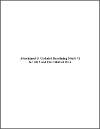Technology Solutions for Wind Integration in ERCOT - Final Technical Report Appendices Part II
Oct. 24, 2014
Center for the Commercialization of Electric Technologies
Texas has for more than a decade led all other states in the U.S. with the most wind generation capacity on the U.S. electric grid. The State recognized the value that wind energy could provide, and committed early on to build out the transmission system necessary to move power from the windy regions in West Texas to the major population centers across the state. It also signaled support for renewables on the grid by adopting an aggressive renewable portfolio standard (RPS). The joining of these conditions with favorable Federal tax credits has driven the rapid growth in Texas wind capacity since its small beginning in 2000. In addition to the major transmission grid upgrades, there have been a number of technology and policy improvements that have kept the grid reliable while adding more and more intermittent wind generation. Technology advancements such as better wind forecasting and deployment of a nodal market system have improved the grid efficiency of wind. Successful large scale wind integration into the electric grid, however, continues to pose challenges. The continuing rapid growth in wind energy calls for a number of technology additions that will be needed to reliably accommodate an expected 65% increase in future wind resources.
The Center for the Commercialization of Electric Technologies (CCET) recognized this technology challenge in 2009 when it submitted an application for funding of a regional demonstration project under the Recovery Act program administered by the U.S. Department of Energy1. Under that program the administration announced the largest energy grid modernization investment in U.S. history, making available some $3.4 billion in grants to fund development of a broad range of technologies for a more efficient and reliable electric system, including the growth of renewable energy sources like wind and solar. At that time, Texas was (and still is) the nations leader in the integration of wind into the grid, and was investing heavily in the infrastructure needed to increase the viability of this important resource. To help Texas and the rest of the nation address the challenges associated with the integration of large amounts of renewables, CCET seized on the federal opportunity to undertake a multi-faceted project aimed at demonstrating the viability of new smart grid technologies to facilitate larger amounts of wind energy through better system monitoring capabilities, enhanced operator visualization, and improved load management. In early 2010, CCET was awarded a $27 million grant, half funded by the Department of Energy and half-funded by project participants. With this funding, CCET undertook the project named Discovery Across Texas which has demonstrated how existing and new technologies can better integrate wind power into the states grid. The following pages summarize the results of seven technology demonstrations that will help Texas and the nation meet this wind integration challenge.


